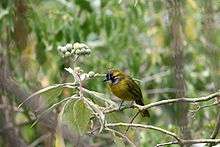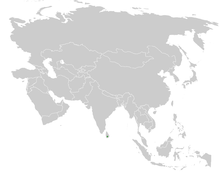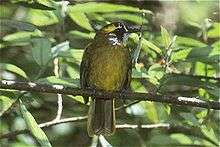Yellow-eared bulbul
The yellow-eared bulbul (Pycnonotus penicillatus) is a species of songbird in the bulbul family of passerine birds. It is an endemic resident breeder in the highlands of Sri Lanka. The common name is also used as an alternate name for the yellow-throated bulbul.
| Yellow-eared bulbul | |
|---|---|
 | |
| Scientific classification | |
| Kingdom: | Animalia |
| Phylum: | Chordata |
| Class: | Aves |
| Order: | Passeriformes |
| Family: | Pycnonotidae |
| Genus: | Pycnonotus |
| Species: | P. penicillatus |
| Binomial name | |
| Pycnonotus penicillatus Blyth, 1851 | |
 | |
| Synonyms | |
| |
Taxonomy and systematics
The yellow-eared bulbul was formerly classified in the monotypic genus Kelaartia, named after Dr. E.F. Kelaart. Alternate names for the yellow-eared bulbul include the Ceylon bulbul, Sri Lanka bulbul and yellow-tufted bulbul.
Distribution and habitat
The yellow eared-bulbul is endemic to Sri Lanka and is the least common of the bulbuls found in Sri Lanka. This is a bird of jungle and wooded farmland. Despite its restricted range, it is quite readily found at sites such as Horton Plains and Victoria Park in Nuwara Eliya and has been frequently sighted in rocky hills.


Description

The yellow-eared bulbul is about 20 cm (7.9 in) in length, with a long tail. It has olive upperparts and yellowish underparts. The crown of the head is grey, and there are yellow ear tufts and a yellow patch below the eye. There is a white tuft in front of the eye and the throat is also white.
Sexes are similar in plumage, but young birds are duller than adults. The flight is bouncing and woodpecker-like.
Behaviour and ecology
Yellow-eared bulbuls build their nest in a bush with two eggs in a typical clutch. They feed on fruit and insects.
Cultural references
The yellow-eared bulbul appears on the 10-rupee Sri Lankan postage stamp[2] and can also be seen on the new LKR රු5000 note of Sri Lanka.[3]
References
- BirdLife International (2016). "Pycnonotus penicillatus". The IUCN Red List of Threatened Species. IUCN. 2016: e.T22712722A94345457. doi:10.2305/IUCN.UK.2016-3.RLTS.T22712722A94345457.en. Retrieved 15 January 2018.
- http://www.birdtheme.org/country/srilanka.html
- http://www.cbsl.gov.lk/htm/english/06_cm/c_4.html#fivethousand
- Birds of India by Grimmett, Inskipp and Inskipp, ISBN 0-691-04910-6
